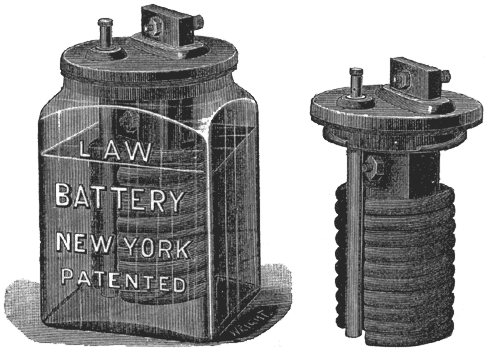[Trade Journal]
Publication: Electrical World
New York, NY, United States
vol. 11, no. 13, p. 168, col. 3
The New "Law" Battery.
In the new form of battery designed by the Law Battery Company, of this city, the negative electrode has been altered somewhat in form from that heretofore employed. As will be seen, Fig. 2, it now consists of a corrugated cylinder, bolted to a conducting carbon, which passes up through the glass cover and serves as the attachment for the binding post. In order to avoid the creeping of salts the conducting plate is saturated with paraffine, and to prevent all action on account of the clamping device, the bolt and the nuts which secure the cylinder to the conducting plate are made of hard rubber. One side of the cylinder, it will be noted, is hollowed out, and in this space the zinc passes down from the cover. The construction of the latter is such that it holds the zinc securely in place without it being possible for the latter to come in contact with the carbon and short-circuit the battery under any conditions. The cell, Fig. 1, is sealed by means of a rubber washer under the cover, which prevents evaporation and the entrance of dust, the cover being kept tight by lugs which screw into the glass jar.
Another improvement to which attention may be drawn is the device employed for obtaining a good contact between the conducting wires and the binding posts. To effect this, the screws entering the posts are tapered conically at their ends, and the holes into which the wires are inserted are not, as usually, bored centrally through the post, but somewhat at one side of the centre. The result is that upon the insertion of the wire the tapered end of the screw forces the wire to one side like a wedge, and this action, combined with the grinding of the screw when turned, serves to make a perfect contact between the wire and the post.
 |
| Figs. 1 and 2. — the New Law Battery. |
